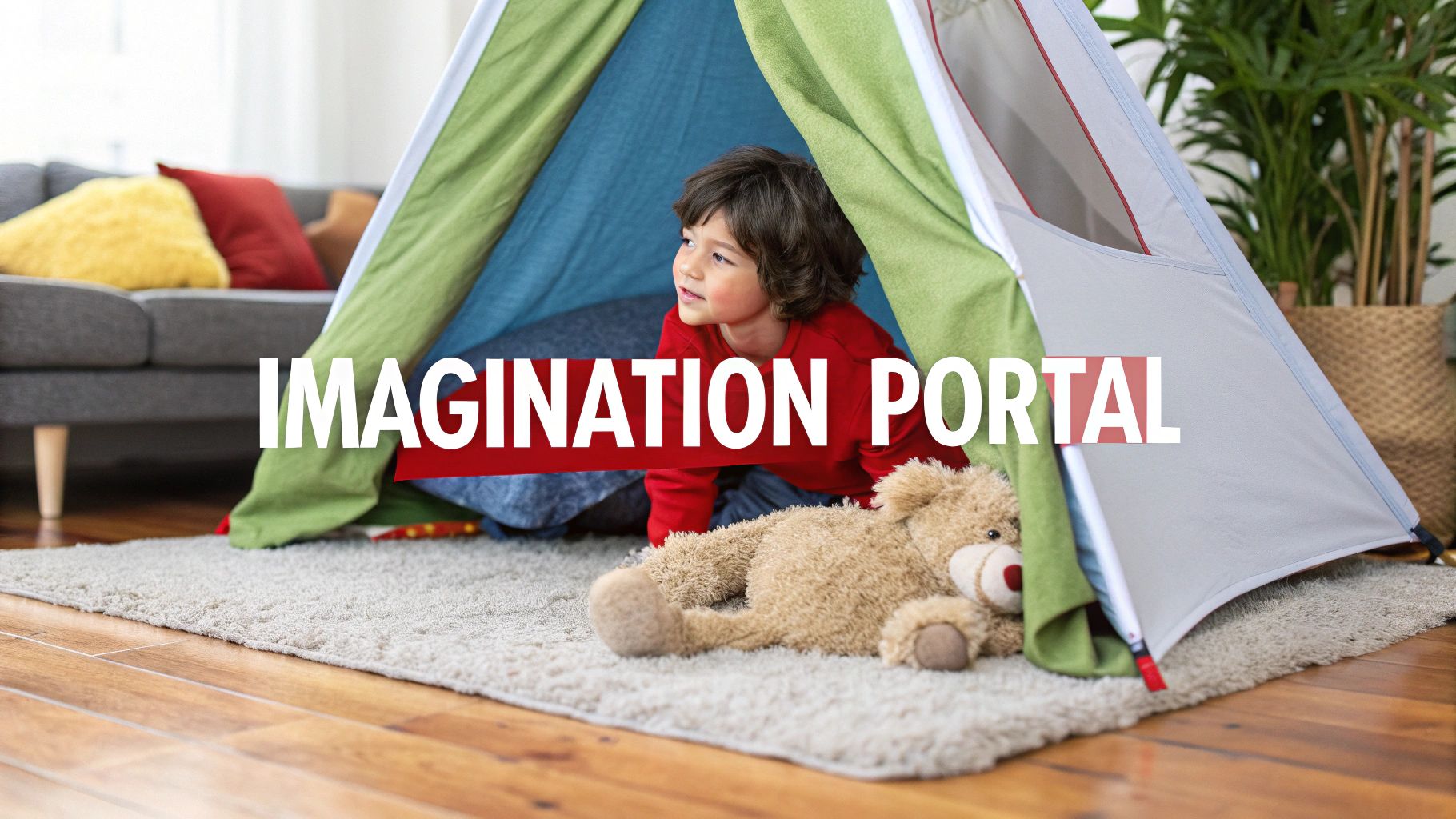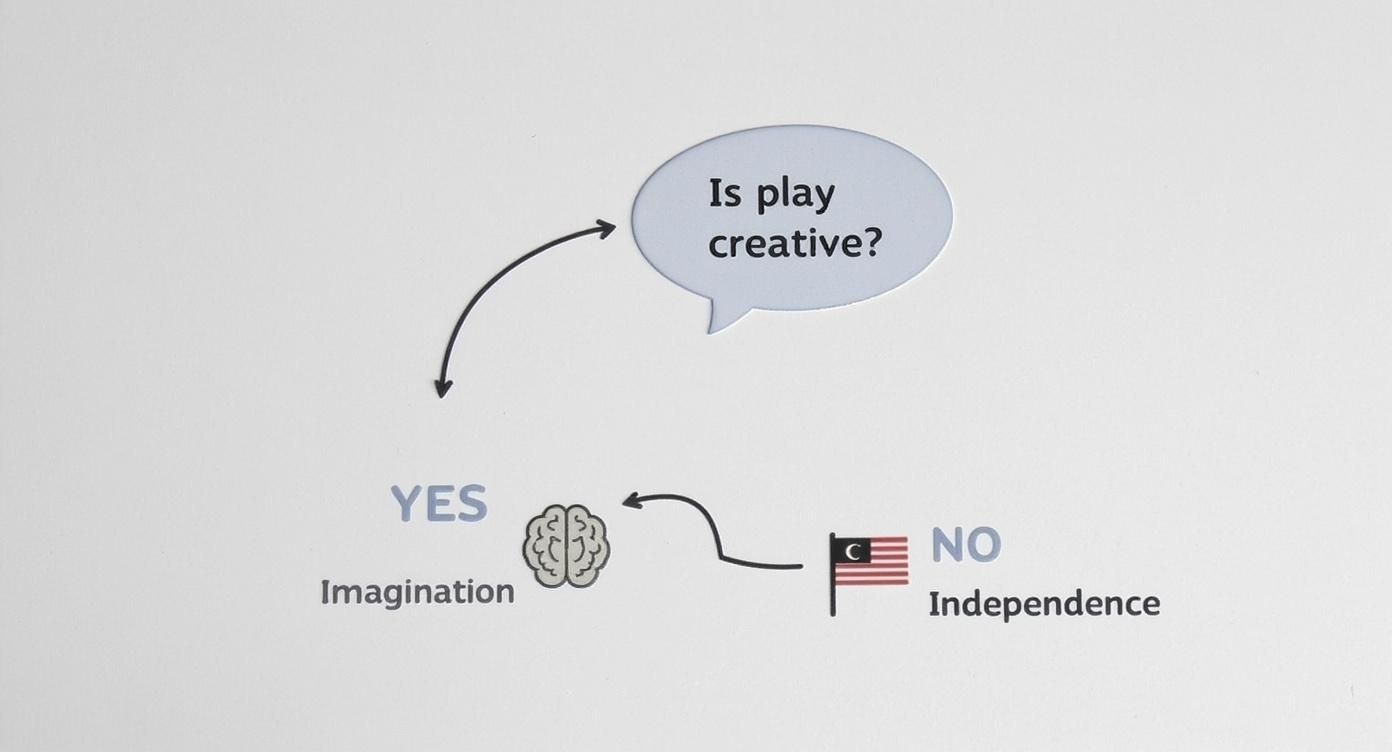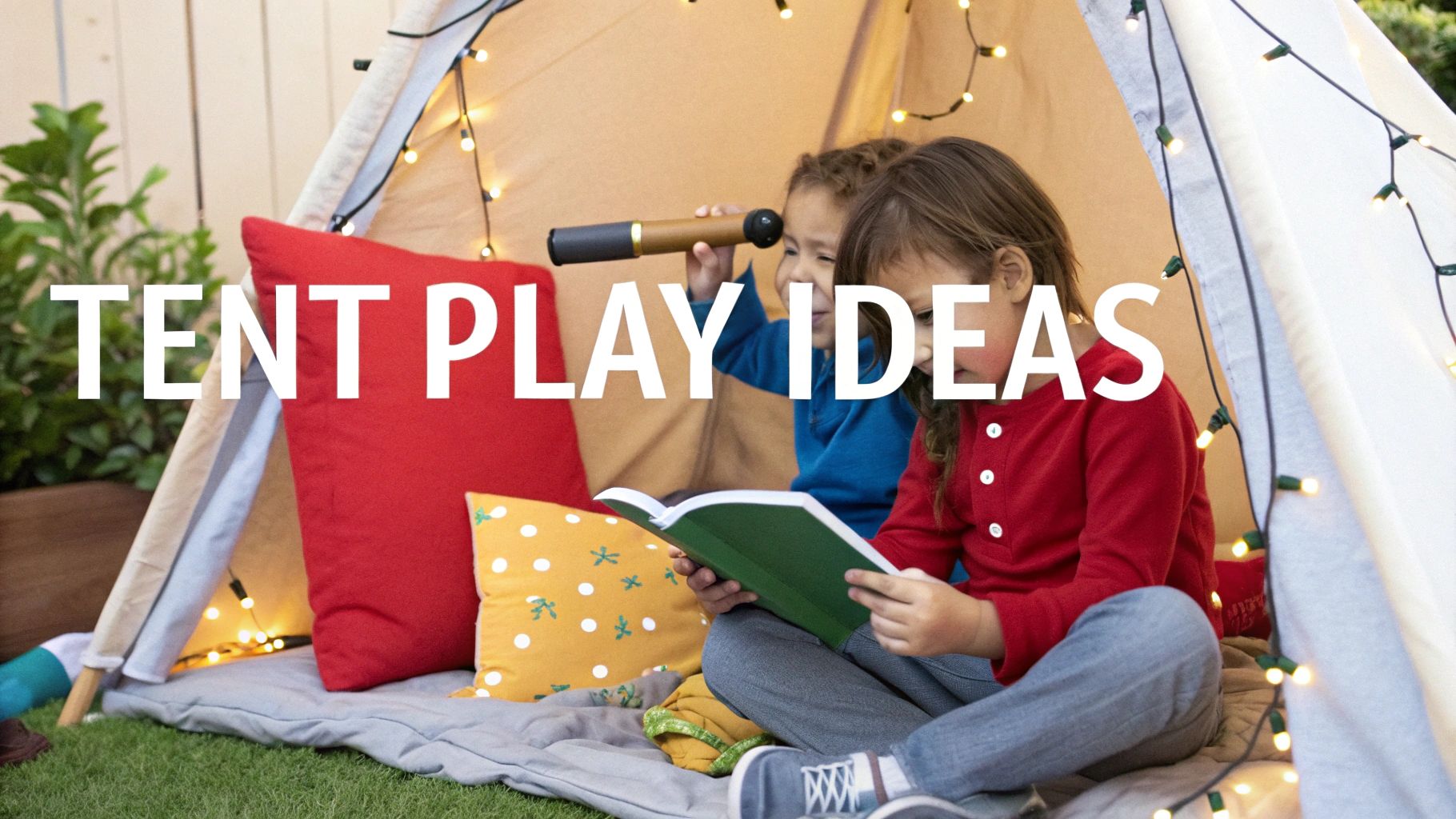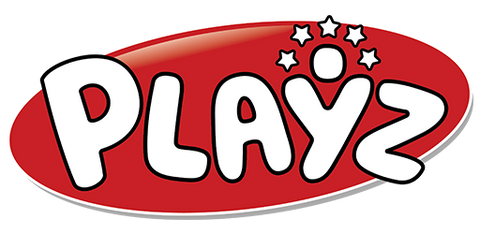
Indoor Play Tents for Kids: A Parent's Guide to Unlocking Imagination
An indoor play tent is more than just a toy; it’s a magical portal to a world of your child’s own making. In one moment, it's a secret fort guarding precious treasures. In the next, it's a spaceship navigating distant galaxies. For your child, this simple structure is their personal headquarters for screen-free adventures, creative problem-solving, and much-needed quiet time.
Why Every Child Needs a Personal Play Space
A play tent is a powerful tool for development, disguised as pure fun. In a world increasingly filled with screens and structured schedules, an indoor tent offers something priceless: an unstructured space where a child is the boss. This sense of ownership is a significant confidence booster and a foundational step toward independence.

This personal space becomes a blank canvas for amazing stories. One day, it’s a vet clinic for every stuffed animal in the house. The next, it’s a castle under siege by a friendly dragon. This kind of open-ended, imaginative play is where some of the most important life skills are born.
Fostering Key Developmental Skills
When kids are lost in their own little world inside a tent, they're not just having fun—they're learning and growing. The benefits ripple across all areas of development, building a strong foundation for school and social life.
A simple tent can support:
- Cognitive Growth: Kids get to plan adventures, solve problems (like how to fit all their favorite toys inside), and organize their own little space.
- Emotional Regulation: It acts as a safe, calming retreat. When the world feels overwhelming, the tent is a quiet spot to process big feelings.
- Creative Expression: With zero rules, kids are free to try on different roles, dream up wild scenarios, and tell their own stories.
Key Takeaway: A play tent gives a child a space that is entirely their own. This autonomy helps them develop a sense of self and learn to manage their own environment, which is a significant step toward independence.
The Power of a Personal Haven
There's a unique sense of security that comes from having a small, enclosed space to call your own. For children, especially those between ages 2 and 5, the world can feel enormous. A play tent is a predictable, manageable environment where they feel safe and in control.
This private haven also encourages solitary play, which is vital for building concentration and self-reliance. It’s in these quiet moments that a child's inner world truly comes alive. They learn to entertain themselves, work through their ideas, and find confidence in directing their own fun.
You can find more ideas to spark creativity in our guide to the best imaginative play toys. It’ll help you see the tent’s true value—far beyond being just another fun plaything.
The Developmental Benefits of a Personal Play Space
An indoor play tent is a dedicated lab for your child's growing mind. Beyond the obvious fun, this personal space is where they start piecing together important life skills, boosting their cognitive, emotional, and social growth all at once. Inside those fabric walls, a child isn't just playing—they're directing stories, building creative confidence, and figuring out the world on their own terms.
A Launchpad for Imagination and Creativity
Inside their own private fort, kids are free to become anyone and go anywhere. One day, the tent is a rocket ship blasting off to the galaxy. The next, it’s a bustling vet clinic for a crew of stuffed animals. This self-directed play builds stronger neural connections and lays the groundwork for real-world problem-solving.
This is where the magic happens. They experiment with roles and scenarios without any fear of getting it wrong, which is crucial for building a resilient mindset. To dig deeper, check out our guide on the benefits of play-based learning.
Parent Tip: A play tent provides a safe space for your little one to retreat to when they’re having big emotions. It’s a cozy sanctuary for playtime or quiet time.
It’s not just us saying it. The Family Entertainment Center market is projected to hit over $40 billion in 2025, a clear sign that parents everywhere recognize how important dedicated play spaces are for their kids.
Fostering Independence and Self-Reliance
One of the biggest wins of an indoor play tent is the sense of ownership it gives a child. This is their space. It’s a mini-home within the home that they manage, organize, and control. That feeling of autonomy is a huge stepping stone toward independence.
By being in charge of their own little world, kids learn essential life skills in a low-stakes environment.
- Organizational Skills: They decide which toys come in and how pillows are arranged. These are the first steps toward real organizational habits.
- Decision-Making: Simple choices, like who gets an invitation inside, help them practice making decisions and seeing the results.
- Responsibility: Keeping their special spot tidy is a gentle, hands-on lesson in taking care of their things.
This dose of independence is a massive confidence builder, showing them just how capable they really are.
Enhancing Cognitive and Emotional Skills
A play tent is also a powerhouse for cognitive and emotional development. When a kid builds a fort, they are actively problem-solving, figuring out how to keep the walls stable or how to fit a new toy into their story. This hands-on thinking sharpens critical thinking and spatial awareness.
Even better, the tent becomes a comforting retreat. When your child feels overwhelmed or frustrated, that tent is a quiet, enclosed space where they can self-soothe. It's the perfect spot to learn how to manage big emotions—a skill that’s absolutely vital for emotional intelligence.
How to Choose the Perfect Indoor Play Tent
Picking out the right indoor play tent doesn't have to be overwhelming. By focusing on a few key factors—your space, your child's age, and safety features—you can find a magical hideaway that will be a favorite for years. Think of it less like buying another toy and more like investing in a special spot for your kid to grow.
The global toy market hit $113.9 billion in 2024, with play tents being a hot item. This isn't surprising, as parents are actively looking for durable, safe toys that get kids playing creatively and away from screens.
Sizing Up Your Space
Before you get your heart set on that magnificent castle tent, pull out the measuring tape. The first step is figuring out how much floor space you can realistically dedicate to a play zone. A tent that’s too big can make a room feel crowded, while one that’s too small won’t leave enough room for adventure.
Pay attention to both the tent’s footprint (its length and width) and its height. Taller tents feel more spacious and can grow with your child, but they need to fit comfortably under your ceiling without bumping into light fixtures.
This infographic breaks down how different features of a play tent can nurture specific developmental skills, from sparking creative play to building a child's sense of independence.
As you can see, whether it becomes a rocket ship for pretend play or just a quiet corner for reading, a play tent is a powerful tool for a child's development.
Matching the Tent to Your Child's Age
The perfect tent for a wobbly toddler looks very different from one an energetic five-year-old would love. Choosing an age-appropriate design is essential for both safety and engagement.
- For Toddlers (1-3 years): Simplicity and safety are key. Look for tents with wide doorways, no small parts, and mesh windows so you can easily keep an eye on them. Simple pop-up designs are fantastic for this age.
- For Preschoolers and Older Kids (4+ years): This is where imagination takes over! Tents shaped like castles, spaceships, or secret forts are a huge hit. They can also handle more complex structures with features like roll-up windows or multiple doors.
Understanding Materials and Durability
A tent's material dictates how long it will last and how easy it is to clean. The two most common choices are canvas and nylon/polyester, each with its own pros and cons.
- Canvas Tents: These heavy-duty tents are incredibly durable and have a classic look. Canvas is breathable and often made from natural fibers. The trade-off? They can be heavier and take more effort to assemble.
- Nylon/Polyester Tents: These are your pop-up and lightweight options. They are a breeze to set up, take down, and clean. While not as rugged as canvas, a well-made polyester tent can still handle tons of energetic play.
You can explore a variety of durable and imaginative play tents to see the range of styles available.
Editor's Note: Consider the frame. Pop-up tents use flexible wire frames that spring into shape instantly, making them ideal for quick setup. Pole-based tents offer more rigidity and a defined shape but require assembly.
Comparing Popular Types of Indoor Play Tents
To make things even easier, here’s a quick comparison of popular tent styles. Thinking about what your family needs will help you find a tent that becomes a fixture in your home.
| Tent Type | Best For | Pros | Cons |
|---|---|---|---|
| Pop-Up Tents | Quick setup, small spaces, younger toddlers | Instantly assembles and folds flat for easy storage; lightweight and portable | Can be less sturdy; may lose shape over time |
| Teepees | Stylish decor, quiet reading nooks, older kids | Aesthetically pleasing, often made of durable canvas, feels spacious inside | Larger footprint; assembly can be tricky |
| Castle/Theme Tents | Imaginative role-playing, themed playrooms | Sparks creativity with fun designs; often includes features like towers and flags | Can have a complex setup; may be bulky |
| Tunnel Tents | Active play, multiple kids, obstacle courses | Modular and expandable; encourages crawling and physical activity | Takes up significant floor space; connections can detach |
Ultimately, the best indoor play tent is one that fits your home, excites your child, and can withstand their endless energy.
Essential Safety and Setup Best Practices
You’ve picked out the perfect tent. Before letting the kids loose, it's crucial to ensure their new hideout is a safe and secure haven. A few simple checks can transform their special spot into the safest fort on the block, giving you peace of mind.
The toddler play tents market, valued at $1.3 billion in 2024, is projected to double by 2033. This growth highlights how much parents are prioritizing high-quality, safe play solutions. You can discover more insights about the toddler play tent market growth to see how this focus on safety is shaping the industry.
Non-Negotiable Safety Features
When you unbox your new tent, play inspector for a moment. The best tents are designed with safety woven right into their structure, built to handle everything from quiet tea parties to energetic battles.
Here’s your quick safety checklist:
- Proper Ventilation: Look for mesh windows or open flaps. Good airflow is key to keeping the tent comfortable and not stuffy.
- Sturdy Construction: Give it a gentle shake. The tent should feel stable. Make sure poles fit snugly and the fabric is pulled tight. A flimsy frame is a no-go.
- Child-Safe Materials: Check labels for non-toxic, flame-retardant materials. Certifications like BPA-free and lead-free provide peace of mind.
Strategic Placement for Safe Play
Where you put the tent matters just as much as the tent itself. The goal is to carve out a "safe zone" around it, away from household hazards.
Before you set it up, scan the room for a spot that is:
- Away from Stairs and Windows: Always set up the tent on a flat, stable surface, far from any potential tumbles. Be mindful of windows with long blind cords, which are a serious hazard.
- Clear of Heaters and Outlets: Keep a safe distance from radiators, space heaters, and uncovered electrical outlets to prevent risks.
- A Low-Traffic Area: Tucking the tent into a corner or against a wall is a great way to keep it from being tripped over or knocked down.
Regular Inspections and Maintenance
A quick, regular check-up keeps the play tent in prime condition. Make it a habit to give the tent a once-over every few weeks, especially after a wild adventure. Look for signs of wear like frayed seams, splintering poles, or small holes. Catching these minor issues early ensures the indoor play tents for kids remains a durable and secure retreat.
Creative Play Ideas to Bring Your Tent to Life
The tent is up and looking magical. Now the real fun begins! An indoor play tent is a blank canvas for your child's imagination, a private world just waiting for a story. With a few simple props—many of which you already have—you can help launch countless screen-free adventures.

The key is to provide a spark of an idea and then step back and let your child take the lead. From thrilling escapades to quiet, cozy moments, the possibilities are endless.
Epic Adventures and Role-Playing Scenarios
For the kid who loves action, the tent is the perfect home base for grand adventures. It can become anything they dream up, setting the stage for hours of imaginative role-playing. This kind of play is fantastic for developing narrative skills and empathy.
Here are a few adventure-themed ideas:
- Space Explorer Mission: The tent is now a rocket ship. Drape it with foil, hang glow-in-the-dark stars inside, and create a control panel from a cardboard box. Their mission? To discover a new planet and collect "space rocks" (crumpled foil).
- Jungle Safari Expedition: Turn the tent into a wildlife explorer's base camp. Fill it with stuffed animals, binoculars made from toilet paper rolls, and a map of the "jungle" (your living room).
- Secret Agent Headquarters: This tent is a top-secret hideout. All they need is a flashlight for sending coded messages, a small notebook, and a "secret password" for entry.
Creating a Cozy Retreat for Quiet Time
Not every activity needs to be a high-energy adventure. Indoor play tents for kids also excel as serene sanctuaries for quiet, focused activities. Creating a calm atmosphere can encourage reading, drawing, and peaceful solitude.
A cozy tent can easily become their favorite spot to unwind. The enclosed space provides a sense of security, helping them relax and recharge. For more hands-on fun, get inspired with these fantastic cardboard craft ideas that can be done inside their new favorite spot.
To set up the ultimate cozy nook:
- Add Soft Furnishings: Fill the tent with plush pillows, soft blankets, and maybe a fuzzy rug.
- Introduce Gentle Lighting: String up battery-operated fairy lights or LED tea lights for a magical glow.
- Stock It with Quiet Activities: Create a small "library" with their favorite books, or add a clipboard with paper and crayons.
Fostering Social Skills and Group Play
A play tent is a wonderful tool for nurturing social skills. When friends come over, its small, defined space naturally encourages cooperation and communication. It becomes a shared world where kids have to negotiate roles, share toys, and work together.
You can facilitate this by turning the tent into a collaborative play space. For instance, it could become a pretend cafe where one child takes orders while another "cooks." It could also serve as a stage for a puppet show. These shared experiences teach valuable lessons in teamwork and sharing.
Got Questions About Play Tents? We’ve Got Answers.
Even after picturing all the fun, it's normal to have a few practical questions. We'll tackle the common things parents ask—from the best age to start to cleaning and safety—so you can feel 100% confident in your choice.
What’s the Best Age for a Child to Use a Play Tent?
Play tents are a huge hit with kids from the toddler years all the way through early elementary school—usually from about age 1 to 8. How they play changes as they grow, and so does the perfect tent style for them.
- Toddlers (Ages 1-3): For little ones, a tent is a simple, safe world for peek-a-boo or quiet time. Simple pop-up tents with big doors and mesh windows are perfect.
- Preschoolers (Ages 3-5): This is the sweet spot for imaginative play. Suddenly, that tent is a castle or a rocket ship. Themed tents get their creative stories going.
- Early Elementary (Ages 6-8): As kids get older, a tent often becomes their personal hideaway for reading or drawing. A cool teepee or a larger, more neutral tent is a great fit.
How Do I Clean and Maintain a Fabric Play Tent?
Keeping the tent clean is easier than you might think. Most fabric tents, especially those made from polyester or nylon, are designed for quick care. For minor spills, a simple wipe-down with a damp cloth and mild soap is all you need. Always check the manufacturer’s care tag first for deeper cleaning instructions.
Pro Tip: Always make sure the tent is completely dry before you fold it up to prevent mildew. Storing it in its original bag in a cool, dry spot keeps it safe from dust and damage.
Many tents can be hand-washed or machine-washed on a gentle cycle—just be sure to remove any poles first. Air drying is always your best bet, since a hot dryer can damage the fabric.
Are Pop-Up Tents Durable and Safe for Toddlers?
Yes, as long as you pick a quality one. A high-quality pop-up tent is built with a strong but flexible frame and tear-resistant fabric that can handle plenty of rough-and-tumble play. They are a parent-favorite for their unbeatable convenience.
When checking out a pop-up tent, look for these safety must-haves:
- A Secure Frame: The internal wire should be completely covered by fabric seams.
- Good Ventilation: Mesh windows are non-negotiable for airflow and visibility.
- A Stable Base: The tent should sit flat and not tip over easily.
- Non-Toxic Materials: Make sure it’s made from child-safe, BPA-free materials.
A well-made pop-up tent provides a perfectly safe and fun space for toddlers to explore.
Can a Play Tent Help a Child with Sensory Needs?
Absolutely. For a child who gets easily overstimulated, an indoor play tent can be a game-changer. It acts as a safe, predictable, and calm personal space where they can go to relax and reset.
The enclosed design naturally dials down sensory input, creating a low-stimulation haven that can help a child de-escalate when they feel overwhelmed. The soft walls provide gentle, comforting pressure that many kids with sensory sensitivities find reassuring.
You can make it an even more soothing retreat by adding:
- Soft Textures: Think weighted blankets, plush pillows, or a fuzzy rug.
- Gentle Lighting: Battery-operated fairy lights or a calming color-changing lamp work wonders.
- Quiet Activities: Stock it with sensory toys, soft books, or noise-canceling headphones.
This little sanctuary gives them a sense of control over their environment, empowering them to manage their own sensory needs.
Ready to unlock a world of imagination for your child? At Playz, we design durable, safe, and inspiring play tents that serve as the perfect backdrop for countless adventures. Our tents are built to spark creativity and provide a special place for your child to call their own.
